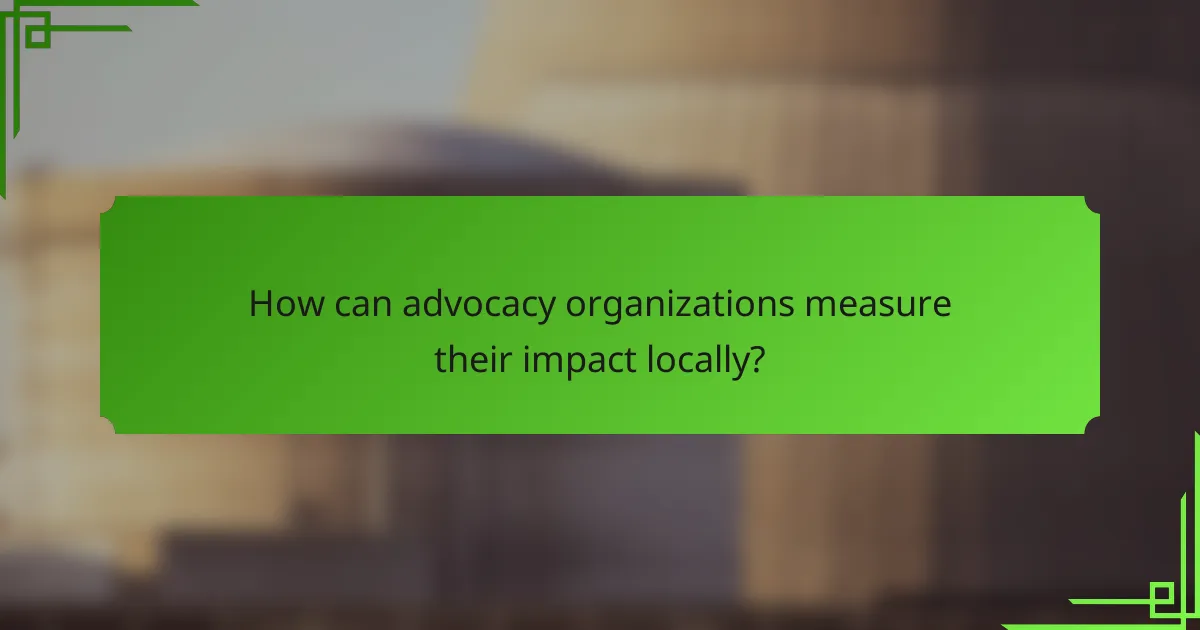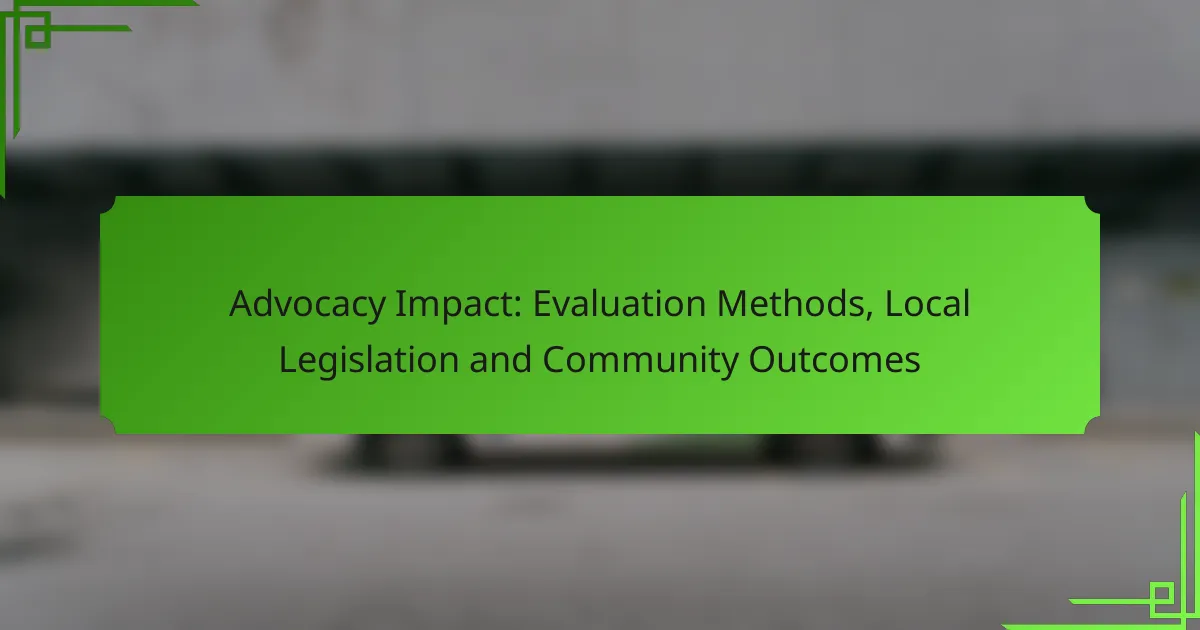Advocacy impact evaluation is crucial for understanding the effectiveness of efforts aimed at influencing policy and community outcomes. By employing a combination of quantitative and qualitative methods, organizations can gauge their success in driving legislative changes and fostering community engagement. Local legislation plays a pivotal role in shaping these advocacy efforts, determining the resources and support available to promote meaningful change. Ultimately, successful advocacy translates into improved quality of life for community members through enhanced awareness, policy reforms, and strengthened social connections.

What are effective evaluation methods for advocacy impact?
Effective evaluation methods for advocacy impact include a mix of quantitative and qualitative approaches that assess the outcomes of advocacy efforts. These methods help organizations understand their influence on policy changes, community engagement, and overall societal improvement.
Quantitative metrics
Quantitative metrics involve numerical data that can be measured and analyzed statistically. Common examples include the number of policies influenced, funds raised, or participants engaged in advocacy campaigns. These metrics provide clear, objective evidence of impact and can be easily compared over time.
When using quantitative metrics, ensure that the data collected is relevant and accurately reflects the advocacy goals. Setting specific targets, such as aiming for a 20% increase in community participation, can help gauge success effectively.
Qualitative assessments
Qualitative assessments focus on understanding the experiences and perceptions of individuals affected by advocacy efforts. This can include interviews, focus groups, and open-ended survey questions that capture detailed feedback. These insights can reveal the deeper impact of advocacy beyond numbers.
To conduct effective qualitative assessments, create a structured approach that allows participants to share their stories and insights. Analyzing themes from this feedback can provide valuable context to the quantitative data collected.
Case studies
Case studies provide in-depth examinations of specific advocacy initiatives, illustrating their processes, challenges, and outcomes. By documenting real-life examples, organizations can showcase successful strategies and lessons learned, which can inform future efforts.
When developing case studies, focus on clear narratives that highlight key achievements and obstacles. Including data and testimonials can enhance credibility and provide a comprehensive view of the advocacy impact.
Surveys and feedback
Surveys and feedback mechanisms are essential tools for gauging public perception and the effectiveness of advocacy campaigns. They can be distributed online or in-person to gather opinions from a broad audience, allowing for a diverse range of insights.
Design surveys with clear, concise questions that align with advocacy goals. Regularly collecting feedback can help organizations adapt their strategies and improve engagement over time.
Longitudinal studies
Longitudinal studies track the same subjects over time to assess the long-term effects of advocacy efforts. This method is particularly useful for understanding how changes in policy or community behavior evolve and the sustained impact of advocacy initiatives.
Implementing longitudinal studies requires careful planning and consistent data collection. Establishing a baseline and regularly measuring outcomes can provide valuable insights into the effectiveness of advocacy strategies over time.

How does local legislation influence advocacy outcomes?
Local legislation significantly impacts advocacy outcomes by shaping the environment in which advocacy efforts operate. Laws can either facilitate or hinder the ability of organizations to promote their causes, affecting everything from funding to community engagement.
Policy frameworks
Policy frameworks provide the structure within which advocacy operates, outlining the priorities and guidelines for action. These frameworks can include local government policies, state regulations, and national laws that dictate how advocacy groups can engage with stakeholders. Understanding these frameworks is crucial for aligning advocacy strategies with legislative priorities.
For example, a city may have a sustainability policy that encourages community-led environmental initiatives, which can be leveraged by advocacy groups to gain support and funding.
Regulatory compliance
Regulatory compliance refers to the adherence to laws and regulations that govern advocacy activities. This includes understanding requirements for reporting, transparency, and ethical conduct. Non-compliance can lead to penalties, loss of funding, or damage to reputation.
Advocacy organizations should regularly review local regulations to ensure they meet compliance standards, such as those related to lobbying or fundraising. This proactive approach helps maintain credibility and fosters trust with stakeholders.
Community engagement laws
Community engagement laws dictate how advocacy groups can interact with the public and involve them in decision-making processes. These laws often require transparency and inclusivity, ensuring that diverse voices are heard in advocacy efforts.
For instance, some jurisdictions may mandate public consultations for new policies, providing an opportunity for advocacy groups to mobilize community input and support. Understanding these laws can enhance the effectiveness of advocacy campaigns.
Funding opportunities
Local legislation can create or restrict funding opportunities for advocacy organizations. Certain laws may allocate public funds for specific causes, while others might impose restrictions on how funds can be used. Identifying available funding sources is essential for sustaining advocacy efforts.
Advocacy groups should explore local grants, public funding initiatives, and partnerships with governmental bodies to secure financial support. Staying informed about legislative changes can help organizations adapt their funding strategies accordingly.

What are the community outcomes of successful advocacy?
Successful advocacy leads to tangible community outcomes that enhance the quality of life for residents. These outcomes often include increased public awareness, policy changes, enhanced community resources, and strengthened community ties.
Increased public awareness
One of the primary outcomes of successful advocacy is heightened public awareness about specific issues. This can involve educating the community through campaigns, workshops, or social media outreach, ensuring that residents are informed about relevant topics.
For example, advocacy efforts around environmental issues may lead to community events that teach residents about sustainability practices. This awareness can empower individuals to take action, fostering a more engaged and informed populace.
Policy changes
Successful advocacy often results in significant policy changes at local or national levels. These changes can address community needs, such as improved healthcare access, better education funding, or enhanced public safety measures.
For instance, a campaign advocating for affordable housing may lead to new zoning laws or funding allocations that support low-income families. Engaging with policymakers and presenting data-driven arguments is crucial for influencing these changes.
Enhanced community resources
Advocacy can lead to the development and enhancement of community resources, such as parks, libraries, and health services. By rallying support and funding, advocates can ensure that essential services are available to all community members.
For example, a successful initiative might result in new recreational facilities or improved public transportation options, directly benefiting residents. Collaborating with local organizations can amplify these efforts and secure necessary resources.
Strengthened community ties
Successful advocacy fosters stronger community ties by bringing people together around common goals. This collaboration can create networks of support, encouraging residents to work together for shared interests.
Community events, such as town hall meetings or advocacy rallies, can help build relationships among residents and organizations. These connections can lead to ongoing partnerships that address various community challenges, enhancing social cohesion and collective efficacy.

What criteria should be used to select evaluation methods?
Selecting evaluation methods requires careful consideration of various criteria to ensure they effectively measure advocacy impact. Key factors include understanding the target audience’s needs, assessing available resources, and determining the timeframe for evaluation.
Target audience needs
Understanding the target audience’s needs is crucial when selecting evaluation methods. This involves identifying who will benefit from the evaluation results, such as community members, policymakers, or funding organizations. Tailoring methods to address these specific needs enhances the relevance and utility of the evaluation.
For instance, if the audience consists of local community members, qualitative methods like focus groups or interviews might be more effective than quantitative surveys, which may not capture nuanced perspectives.
Resource availability
Resource availability plays a significant role in determining which evaluation methods can be realistically implemented. Considerations include budget constraints, staff expertise, and access to data collection tools. Evaluators should assess what resources are at their disposal to avoid overextending their capabilities.
For example, if funding is limited, opting for low-cost methods such as online surveys or existing data analysis may be more feasible than conducting extensive field studies that require significant investment.
Timeframe for evaluation
The timeframe for evaluation is another critical criterion that influences method selection. Different evaluation approaches require varying amounts of time for planning, data collection, and analysis. Establishing a clear timeline helps in choosing methods that can deliver results within the desired period.
For instance, if an evaluation needs to be completed within a few months, rapid assessment techniques like quick surveys or pre-existing data reviews may be more suitable than comprehensive longitudinal studies, which could take years to yield results.

How can advocacy organizations measure their impact locally?
Advocacy organizations can measure their local impact through various methods that assess community engagement, policy changes, and overall outcomes. Effective evaluation often combines quantitative data with qualitative insights to provide a comprehensive view of their influence.
Local surveys
Local surveys are a direct way to gather feedback from community members about the effectiveness of advocacy efforts. These surveys can include questions about awareness of issues, perceived changes in local policies, and overall satisfaction with community initiatives.
When designing surveys, consider using a mix of closed-ended questions for quantitative analysis and open-ended questions for qualitative insights. Aim for a sample size that reflects the community’s demographics to ensure the results are representative.
Partnership with local universities
Partnering with local universities can enhance the evaluation of advocacy impact through access to research expertise and resources. Universities often have programs focused on social sciences that can provide valuable methodologies for assessing community outcomes.
These partnerships can involve student-led research projects, internships, or collaborative studies that analyze data collected from advocacy initiatives. Engaging with academic institutions not only strengthens the evaluation process but also fosters community awareness and involvement in advocacy efforts.
